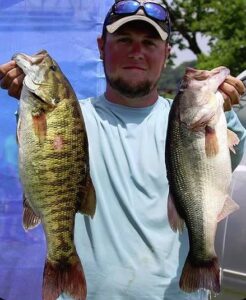PLEASE SHARE
WE ARE YOUR SOURCE FOR FISHING DESTINATIONS IN ALABAMA!
Fall Bass Fishing on Pickwick Lake

The hottest smallmouth bite on the planet begins in October on the Tennessee River.
By Eileen Davis
For an experience of a lifetime, make Pickwick Lake your fall fishing destination. The hottest smallmouth bass bite on the planet begins in October when the water temperature cools into the mid-70s and continues well into December. Pound-for-pound, no other freshwater fish can match the fight of a smallie as it explodes into the air, flipping its body to throw the hook. Additionally, this 43,000-acre lake on the Tennessee River offers exceptional fishing for largemouth.
Winning tournament angler and guide David Allen of Florence usually targets both species in a day’s fishing. In the fall, he fishes for smallmouth in the morning and then midday moves downstream to catch largemouth. Allen reports anglers can expect to catch 10 or 15 smallmouth weighing 3 to 4 pounds, with the possibility of catching a 5 or 6 pounder. The largemouth bite produces five to 10 fish, with the best five fish weighing more than 20 pounds.
“The thing about fall fishing,” Allen said, “is that it is less technical than fishing in spring. It’s a great time to take children fishing and drift live bait. There are times while fishing live bait when smallmouth will hit all three rods at the same time.”
Most anglers throw a cast net near the Wilson Dam to catch threadfin shad, but Allen says the shiners sold at Perkins Outdoor also work well for catching smallmouth. He fishes live bait on a No. 1 or 2 live bait hook with a No. 4 or 5 split shot 6 to 12 inches above the hook.
“Fish live bait,” Allen explained, “by casting it upstream and letting your drifting boat pull the bait. Even though smallmouth is the target species, you may catch drum, white bass, big spotted bass and an occasional striped bass. It is a simple but effective technique.”
Allen recommends fishing the upper lake between 7-Mile Island and the Wilson Dam. Align your boat to drift over boulders and through current beaks. Every time you catch a fish save a waypoint so you can repeat the drift.
When Allen switches to largemouth, live bait fishing gives way to fishing topwater lures over schooling fish and isolated cover. He fishes for largemouth downstream as far as Waterloo and looks for shallow points, pea gravel banks, humps, creek mouths and expansive stump flats. Allen says it’s essential for these areas to offer both a current break for shad and a place for bass to ambush their prey.
“If you see a point or pocket with schooling fish,” Allen said, “often the fish busting shad on the surface are going to weight 1 ½ to 3 pounds. To catch big largemouth, fish a big topwater lure next to a single stump. There may only be one fish on the stump, but it will be a monster waiting to attack an 8-inch gizzard shad.”
To target bucket mouth size bass on isolated cover, Allen’s go-to lures are Heddon’s Saltwater Super Spook and Cotton Cordell’s Pencil Popper. He fishes both on 50-pound-test braid.
“The braid allows for long distance casting with no stretch in the line,” he said. It makes it easier to keep the fish hooked. In some places it necessary to make long casts as the fish may only be in a foot of water on a large flat.”
When fishing with children, Allen has them casting River2Sea’s Whopper Plopper 130, which is a 5-inch topwater with a rattle.
“This lure in a shad color,” he said, “will catch some of the biggest bass they have ever seen by fishing it in the fall on Pickwick Lake.”
For more information on area attractions and outdoor recreation opportunities, visit www.colbertcountytourism.org.
To learn more about David Allen and book a guide trip visit www.davidallenfishing.com.
Read more about how successful anglers find and catch Bama’s fish.
